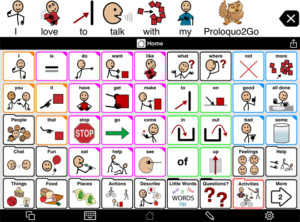Overview:
While hearing technology in itself is monumental and can change lives, not all hearing aid and cochlear implant recipients reach this level of success. Sometimes, we must rely on other modes of communication when auditory and manual methods are no longer an option. This is often seen in the case of deaf children who also experience motor difficulties. Assistive technology is extremely broad and refers to any sort of device that may assist in the communication process, but a more narrow and common approach is that of Augmentative and Alternative Communication (AAC).
AAC can take several forms (from pen and paper to high tech devices⁴), but the purpose is the same: to replace or supplement speech or other expressive language² in children with language impairments or who cannot otherwise communicate. Naturally, not all deaf children have language disorders, but AAC devices are still useful as a resource for modeling or providing an alternate means of communication for those who are unable to use the more popular and widespread methods (i.e., speech and sign language). This allows for a more inclusive and welcoming classroom environment. Conversation is a common need among humans that AAC devices can assist in fulfilling.
Pros and Cons of AAC (Tech) Devices:
Pros:
- Allows for individuality and autonomy
- Can be used to whatever degree necessary; supplementary material or complete communication
- Encourages family involvement
- Relatively low costs if program is available as an app
- Portable
- Improves participation
- Children are able to express their basic wants and needs
- Usually kid-proof
- Typically customizable
- Reduces frustration in students who aren’t able to communicate effectively
Cons:
- High costs if program is only available as a device
- Lack of training
- Connecting pre-recorded speech may lead to deficits in grammar knowledge
- Efficiency; there isn’t one device that fits all AAC users, and you might have to try several before finding the right fit for you or your child/student
- In most cases, the speech produced with AAC systems lacks innate prosody and may make recognition of natural speech rhythms difficult
Augmentative and Alternative Communication in Language
While the effects of AAC devices are not heavily documented, using AAC with a student allows you to see the improvements in language.
Aside from sometimes completely replacing speech, this technology aids in repairing communication breakdowns and acts as another avenue for social exchanges. Furthermore, AAC can also promote language by modeling speech patterns or simple words and phrases for the basis of a child’s imitation. Note that AAC is most often used in the oral therapy approach to Deaf education.
In another sense, the AAC produced language helps to scaffold a student’s own language on its own and with the assistance of the instructor. For example, when a child is struggling to speak, sign, or communicate in another manner, a teacher may prompt expression by saying “Maybe you can show me what you had for lunch on your iPad,” at which point the child is likely to follow the instructions because they want to convey their message. Over time, the student learns on their own to use their device when they need to communicate, and less prompting is required.
Thus, using an AAC in deaf children is likely to assist in language gains by:
- Eliciting expressive responses
- Requiring comprehension as a foundation for communication
- Expanding vocabulary
- Syntactical rules of sentences (but not necessarily more specific grammar)
- Acting as a model of speech production
- Over time, speech intelligibility
AAC in the Classroom:

In most cases, only one or a couple of students in a Deaf education classroom would require an AAC device. While making a classroom technology-friendly is critical to the success of this student, it is not difficult when hearing technology is already at play. One key aspect is to encourage communication between the student using AAC and their peers in order to normalize the use and allow for a collaborative environment.
The usual going around the circle approach used in many Deaf education activities still works with AAC as long as the device is programmed to include the components and vocabulary necessary for the lesson. For example, the AssistiveWare Proloquo2Go program for iPads is a speech generating mechanism that allows you to add icons for people, places, objects, emotions, and actions to be voiced artificially. In the storytelling technique of working on comprehension and prompting spoken responses, a student using an AAC would first indicate their answer on their device, and if possible, model their own speech production after the device. The addition of all classmates, teachers, and nurses or other specialists aids the student in expanding their knowledge of sounds that they may not hear otherwise but is still vitally important to communication.
One simple activity that can be performed using this AAC device is naming classmates based on the speech generated model. You can use this as a Valentine’s Day activity, in which each student has to go around the circle and say “I love Jacob,” then “I love Miss Ally” until the circle is complete. Your student using AAC can develop an understanding not only of the language and sounds used in expressing their love that they can expand outside of the classroom (their parents will love it!), but in the social rules of turn taking and everyday exchanges.
Keep in mind that students don’t come to class already knowing how to use an AAC device – it might be up to you to introduce the topic and to teach them how to communicate effectively. In order to promote use of the device, you might consider using real life actions and objects to prompt responses on a keyboard. In teaching the connection of “NO” and the X icon on the board, you can present objects that the student doesn’t enjoy to elicit a negative response. If they click on the X icon, associated with NO, you can remove the unenjoyable object away, and over time the student will make the association between NO, the red X picture, and dislike. This exercise can increase understanding of the tool, but also motivate³ the student to communicate their needs and desires more frequently now that they have a grasp on how to do so.
Overall, AAC systems are a powerful tool in many kinds of special education classroom and allows for the development of language, cognitive, emotional, and social skills when other means of communication are not possible.
AAC-Friendly Activity: All About Me
A helpful activity in introducing AAC to a student is to have them create an “All About Me” booklet (with assistance if motor abilities are limited) using the images depicted on the board. This can strengthen the connection between words and their icons and help students understand how the icons may fit together to create a fairly grammatical string of words conveying meaning. View the following examples from occupational therapist Paige Hays. 


Notes:
2 – Expressive language; the Broca’s area of the left temporal lobe is involved with spoken or expressive language. Even in sign language or any manner of communicating, this area is necessary to convey messages to others. Underdevelopment or damage to this area of the brain can result in attained deficits of expressive language. When expressive language is not physically possible but the Broca’s area is supportive of communication, AAC is an optimal method for transmitting messages.
3 – Motivation; Motivations are the psychological processes involved in the direction, vigor, and persistence of behavior. The humanistic approach to motivation suggests that our basic needs and desires drive our behavior. When children are able to effectively use AAC systems, their desire to have their needs met is more easily expressed. Because they want to have needs fulfilled, they are motivated to use their language skills to communicate this.
4 – Computer-Adaptive Instruction; Computer-Adaptive Instruction (CADI) is the use of technology to assist learners with special needs such as psychomotor problems, visual difficulties, or hearing impairments. Naturally, this is a great fit for deaf preschoolers involves the use of AAC devices. Teachers should be trained in the use of these devices in order to promote optimal cognitive and language growth in students.
